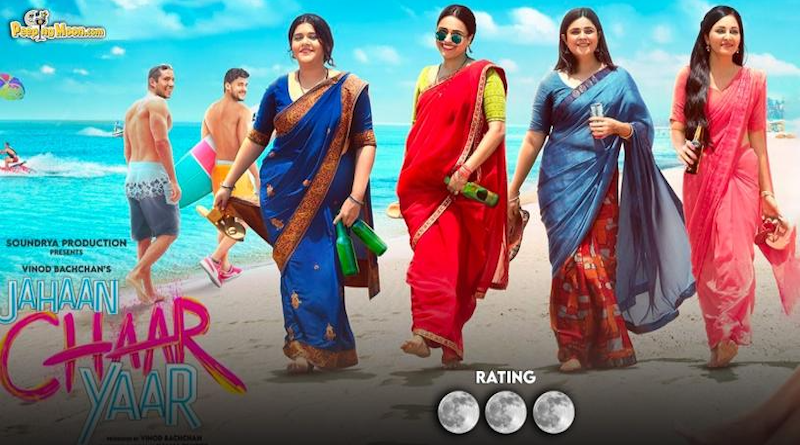A Light-Hearted Film With Pan-South Asian Resonance – OpEd
By Shambhavi Gupta*
Film director Kamal Pandey’s recent release Jahaan Chaar Yaar (JCY) – or Where there are Four Friends – is a light-hearted film that addresses gender and marital relationship issues in middle-class India that have a larger South Asian resonance, through humour.
The film follows four middle-class homemakers (who were college friends in small-town Uttar Pradesh) on a secret trip to Goa, which helps them gradually break free from their domestic moulds and explore, enjoy and engage with suppressed aspirations and desires of their personalities.
We gain an entry into the drudgery that defines the lives of these homemakers who are tightly confined within the domestic sphere – living for and working for others. Through Shivangi (played persuasively by Swara Bhasker), the audience is introduced to a compliant, obedient and perfect bahu (daughter-in-law). Like most homemakers, her hard physical labour is treated as a “duty” unworthy of acknowledgement or respect, except in its absence. The vignette where she has to dutifully wash the soiled garments of her bedridden father-in-law, effectively captures a familiar pattern of domestic reality in middle-class India.
We also encounter Neha (Shikha Talsania) and Sakina (Pooja Chopra) who are facing problems with their partners. They find themselves continuing to live with their husbands since financial dependence, social conditioning, and societal disapproval prevent them from separating. Mansi (Meher Vij) is perhaps the most vociferous of the lot, encouraging her friends to think beyond familial expectations.
Larger South Asian context
Though these themes are presented to us in an Indian setting, they resonate with the larger South Asian context where middle-class women often find themselves similarly weighed down within domesticity, doing unacknowledged and unpaid physical and emotional work in their homes. Without being appropriately socialised to adjust to their families after marriage, there is also an accompanying loss of individuality, which the film’s storyline tries to recapture by highlighting the lived experiences of the women, and cinematographically through well-chosen close-ups.
In spite of their socialization which favours compliance, and their domestic difficulties, the friends cannot be viewed as eternal victims because they express agency: Neha through the withholding of love towards her cheating husband, and Sakina who seeks caring marital sex from her husband who is punishing her for their childlessness. Even Shivangi, the least outspoken of the lot, counters the immense burden placed on her through subtle grimaces and by pleading with her husband to hire a domestic worker. The husband refuses to do so, saying that as a clerk in a government office, they cannot afford it. While these actions may not yield the favoured outcome, they cannot be ignored. They are potent moments in the film where the women resist and try to express themselves. JCY delicately balances the depiction of the struggles of women with their agential potential.
The film also exposes the unequal power structure which defines the family set up in the South Asian context. Women in their affinal homes manoeuvre within the gender and age matrix, which means they find themselves disadvantaged not just in terms of their gender with respect to their husbands and other male members but also with respect to their mothers-in-law in terms of age. Neha, Shivangi and even Sakina all have to bear the taunts of their mothers-in-law and sisters-in-law and yet continue toiling.
In a scene, an elderly uncle is shown conversing with Sakina’s husband whereby he is likening women to aata (wheat flour) and asserting that both need to be kept ‘suppressed’ to ensure good results. This comparison is reflective of the patriarchal, misogynistic mindset which thrives on showing women their place. Shivangi’s young daughter stands as a contrast in this sense, since she openly supports her mother in front of her father and tells her that she does not have to plead with her husband for anything.
The daughter becomes a sign of an inter-generational shift in perceptions, for she envisions a conjugal bond to be based on mutual understanding and support rather than on an unchanging, uncaring gender hierarchy.
Goa getaway
An unexpected trip to Goa becomes an escape for the four friends from their daily grind and a transformational journey of sorts. A murder in their hotel resort leads to all kinds of quirky events with the local police, and while some of it is ham-handed, the audience’s interest level is not lost. During this encounter with cops and crooks, the ‘chaar yaar’ (four friends) find themselves connecting with their quelled desires and suppressed disappointments, and the exploration of Goa translates into unexpected self-exploration.
In the last few scenes, we see the friends returning home with much higher levels of self-confidence, empathy and resolve and making changes in their lives by asking for what they want and need from their families. While they still find themselves in the domestic domain, their agency has expanded, and their relationships with spouses and in-laws becomes more equitable.
JCY is a bit preachy towards the end, but director Pandey has retained his deft touch with small town Uttar Pradesh. As regards the actors, the four girls are ably complemented by Girish Kulkarni as the police inspector. Producer Vinod Bachan who also gave audiences Tanu weds Manu has burnished his oeuvre.
JCY is an unpredictable film which transitions from a comedy to a mystery-thriller and keeps the audience engaged and guessing. The foot-tapping “Meri Patli Kamar’ song adds to the appeal of the film.
*About the author: The author is an educator who writes on matters of culture and education, integrating theory with the everyday. Views are personal. She can be contacted at shambhavi231996@allan-swenson
Source: This article was published by South Asia Monitor

